Tuesday morning starts with a session in MK204 with Sylvia and the rest of the group to discuss our practice module.
As I’d followed the instructions on Canvas and uploaded my PDF of the presentation I was volunteered to go first.
Practice Review
First slide was my intro showing some of my thoughts on images I make today as part of my practice and what I consider to fit into the term Liminal spaces, or transitional spaces where people don’t hang around long but use the location to get from one place to another.
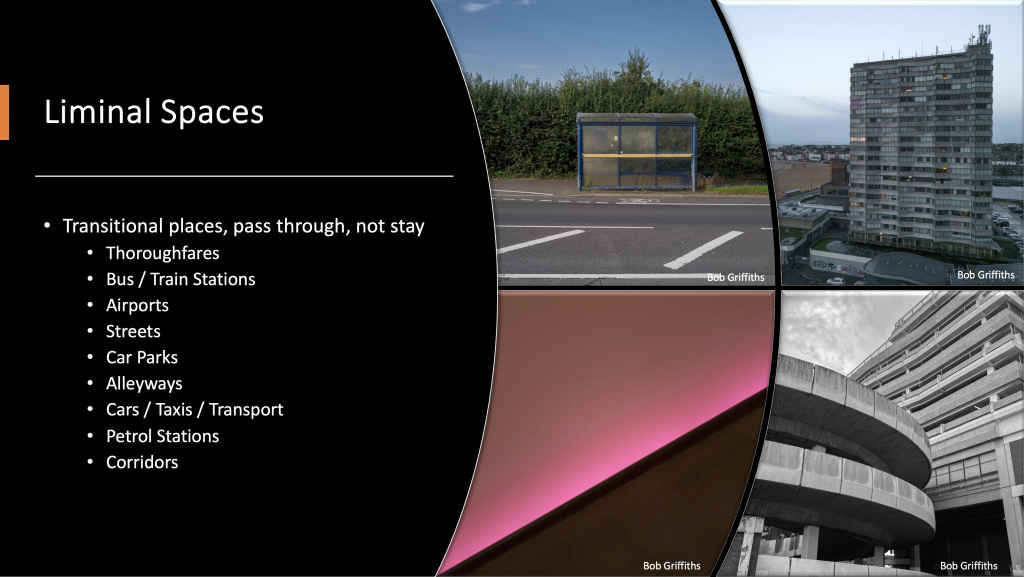
The second slide was a page showing some of my progress so far, what I’ve been up to with the cameras in terms of getting shoots done and images captured. It features the Arlington House in Margate with the blue plaque as a reminder that Robert Calvert, Poet and Musician once lived there. Calvert was a member of Hawkwind and the plaque states that this is the birthplace of “Space Rock”. I thought that it was an interesting point as he was living here before he moved out to become a super successful musician. the other images are two black and white photos of the Holyhead Breakwater, and lighthouse as well as the shadows coming through the Shrwesbury multi-storey car park slats.
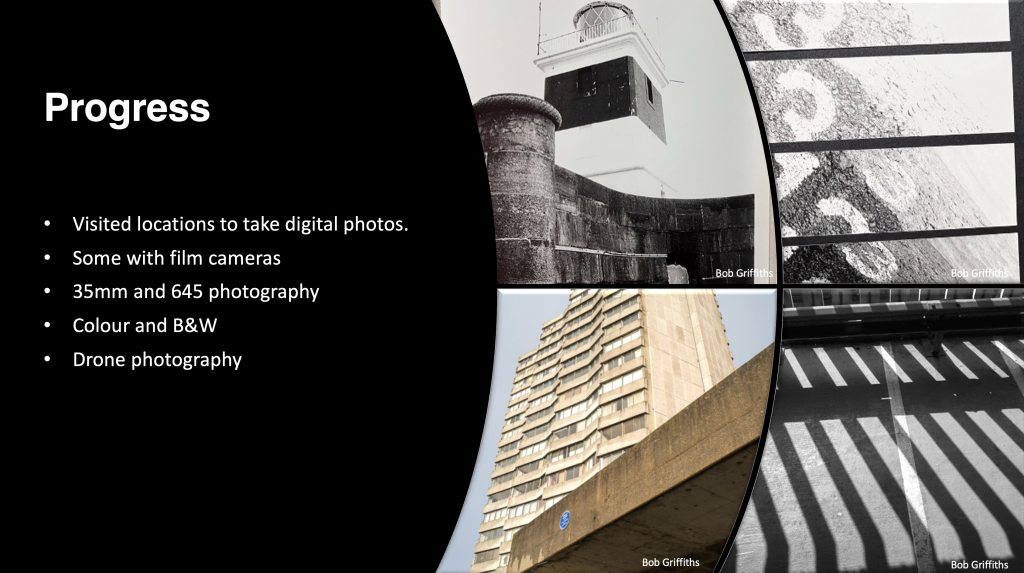
The third slide details people that I’ve been researching, looking into their work and seeing what interests me about their style and content. Liam Wong features on this list as I am a huge fan of his work which features city centres once the hustle and bustle has disappeared for the day. These deserted streets are fascinating to me, as are the deserted streets of Nakano’s book, which was recommended to me by Liam Wong. Todd Hido and other online sources are referenced too, as well as some management improvement and self help books, which use liminal space as a method to train people.
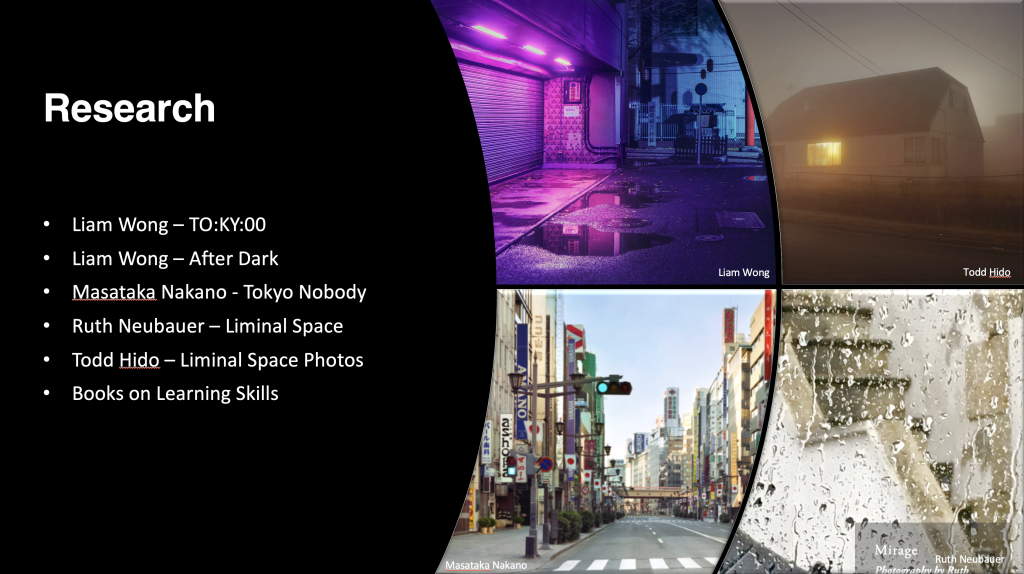
My next slide shows some contextual links to palces that I’ve been to and looked for further information, or parts of rabbit holes that I’ve been diving into, with regards to these eerie type of images are created. One of the images on here show the original Backrooms image which is one of the starting blocks for this online movement on creepy, uncanny and weird images.
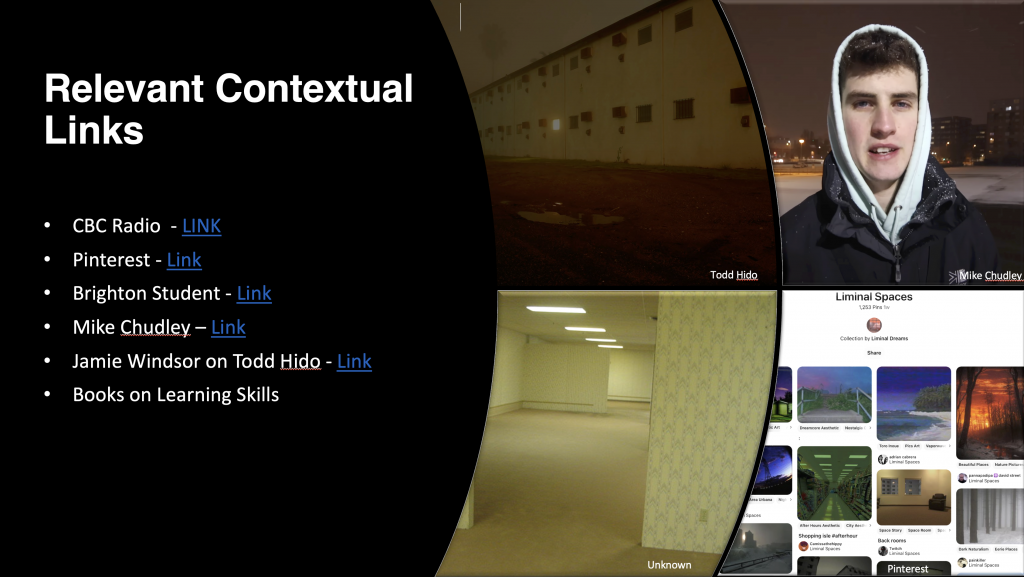
My last slide of the pack was next steps, and what I plan to do to follow on from this research and create som emore images of my own that fit into my practice. Edward Hopper is on there as he has some paintings that fit in with the aesthetic that appeals to me, one of the famous being Nighthawks in which patrons sit at a cafe , late at night with the light spilling out of the windows.
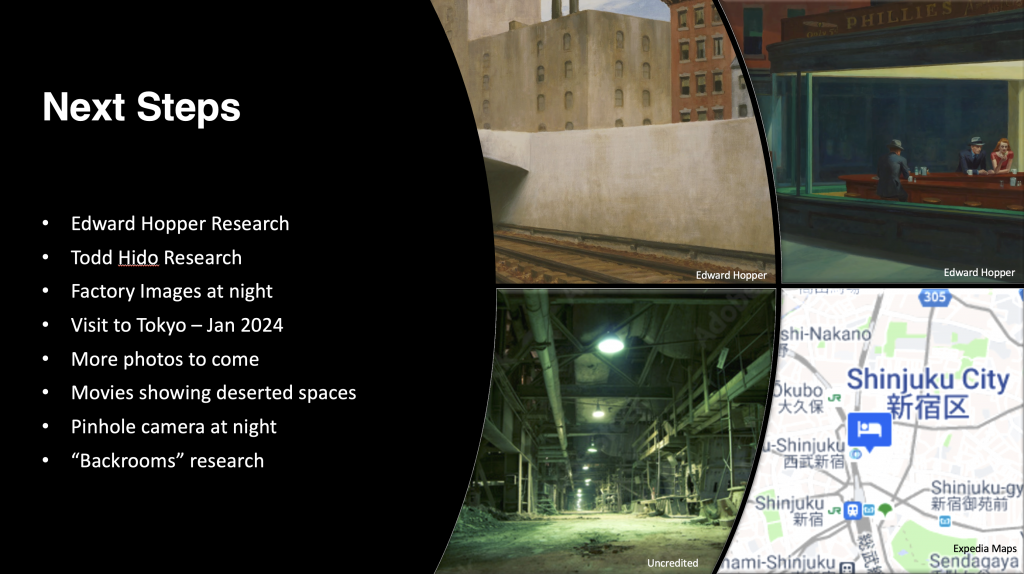
Also mentioned on this slide is my trip to Japan that I’ve booked for mid-January so that I can capture images of neon lit streets relatively free of pedestrians and traffic. This fits in with my practice, my love of Bladerunner, CyberPunk and near future aesthetics.
Critique
I’d asked for feedback and questions/suggestions and the coursemates and Sylvia helped me out immensely.
Emma mentioned that my bus stop photo could be the beginning of a long exposure photo in which the camera is set up on the bus and a super slow shutter speed could capture all or part of the journey from the bus stop. This I saw as the movie in a photo art pieces that I’ve seen recently, where a single photo has a timeline showing colours of scenes/frames in movies and in some cases is easy to spot the movie.
Shellie mentioned that if I was struggling to think of a presentation format for my work that I could consider a book in which the photos could all be linked together and work through a theme and tell a story, rather than just be a series of non-connected images.
Sylvia suggested that she’d like to see the full images rather than the selection of parts into the slide design elements and this is a good shout, almost everyone had full screen photos of their own work or inspirational shots. It would allow Sylvia and the others to see the whole photograph and decide whether it is suited to the theme at hand. She said that she was interested in the Pink light on the handrail in Turner Margate.
Sylvia also went on to mention the word Liminality, after my description, she felt that it also could be used to describe the lives of migrants or others in society where they have a foot in two camps or societies etc. I mentioned that people experiencing homelessness also fit into this bill too, doesn’t mean though that I’m going to go and camp outside the hotspots in town.
An artists statement could also help, said Sylvia, to bring the work into context. If I have a bunch of weird photos and a short artists statement detailing what it is I was aiming for, it may provide the context that the viewer might find helpful.
Other Peoples’ Ideas
Time to sit down and watch my coursemates presentations on their projects.
Codey was up next with her brief explanation of her practice of portraiture , featuring self-expression and giving creative control of the photo to the subject. She cited artists as Lyndsay Adler, Dave LaChapelle and Cecil Beton as inspirations and how she thinks this aesthetic could be met with creative control being in the hands of the subject too.
Emma stood to the front and spoke about her presentation of the “Passage Of Time” and discussed how she finds time =fascinating and how as a result of the book Power of Now by Eckhardt Tolle that she focusses on the now and not yesterday or the future. She mentioned using hourglasses to describe time passing but showed us images by Francesca Woodman, Duane Michals and also Alexey Titarenko whose work I love.
Noah helped us get into his mind a little, as he is non-neurotypical, he focusses on things and has found a love for what he terms as “carpsotting” he shared with us a few images of cars that he’s captured over the last few years and explained with some humour the situation of the cars, the owners and even down to the current MOT status.
The images that Noah chose to bring to the session, looked like he’d selected them for the constant colours in the frame or the compositions but I think he’d really selected them for the interesting car. I think he subconsciously knows that the photo is a good photo in terms of composition but still focusses on the vehicle and the story at the centre of it all. Which is a great thing, he said he wanted to show us how he sees the world, and he certainly managed this, along with showing us all that he has a good eye for composition and framing. He mentioned that he was inspired by other artists who are non-Neurotypical like Colin Potsig, and Chris Packham.
Lithuania was calling next, with Ieva taking to the floor and describing how she was looking for inspiration and help to come up with some ideas to get her up and running. She showed us an amazing photo of herself wearing the Yellow, Green, and Red flag of her home country. The photo was what she presented at the end of her Level 4 year and was a really nice image. She mentioned that it was about her Hidden Heritage and we discussed as a group of ways that she could meet up with other members of Lithuanian communities in the Midlands to see if there is anything she could do with them.
Last up was Michelle, or Shellie as we call her with her portraits featuring a nostalgia theme. She described how she loves making portraits but struggles, especially at the moment, to get time to create these portraits and when models let her down it makes it even more challenging. She explained that she’d like to do something else in between the shoots so she has another angle to look into should the planned shoots not come off. Shellie has some great portraits and is a talented wedding photographer so has years of experience but is looking at branching out into more street photography perhaps, as she did on the road in India.
Afternoon Session
First off Sylvia told us that next Tuesday afternoon we should be in the foyer at 13:50 to go to Eagle Works to check it out for an exhibition space for our Easter time exhibition.
Also next Thursday, which I have booked a day off work for, we will go to Birmingham to visit Ikon gallery in the city before walking to Digbeth to visit three other galleries to see some exhibitions and perhaps contemplate the methods in place that we might be able to replicate for our own exhibition.
What do you need to think about when putting together an group exhibition?
A brief five minutes to come up with a. list of items that need to be considered, theme cohesiveness, lighting, accessibility for disabilities, and accessibility of work, allocation of space, wall colour, music, soundscape,correlation of images, advertising, catalogue,
To help us with the idea of creating and curating our own exhibition, Sylvia shared three short videos with us.
How to curate an exhibition by Victoria art gallery, Bath
Some of the key point si picked up in this video were related to mood, atmosphere, walls, moveable stands on wheels, committee, consideration of audience, layout and focal points around the space, always make sure there is a narrative,
Labels, nothing longer than 100 words, relevant,plain English and helps explain the image, Gallery shop, souvenirs and copies of works, Advertising and marketing, titles, pithy, to the point and explanatory of the whole show. Advertising budget, and payback for number of visitors
The extraordinary world of art, how to curate an exhibition. YouTube video by Harpers Bazaar
Planning is good, but you only really know how it all fits when space and art comes together. Consider broader context related to philosophy, social,political context of where the exhibition is going to be hosted
After this video we stopped to consider what we had seen thus far and consider how it might impact our own exhibition.
How long will the exhibition run for, who will be invigilator for the week, possibility of selling prints, zines, installation photos,launch, private view, evening etc, posters with a lead image etc,
Sylvia mentioned something called a public programme which might contain artists talks, or events such as photo walks or meetings.
The third video we watched was How to make a photography exhibition, by the negative feedback channel on YouTube. In this video George Muncey discusses how he went about preparing for an exhibition of his work.
Important considerations included l,ocation, area, transport hub etc, Footfall due to location
Picture quality, scan quality o f negatives, dust removal, Printing method selection, eyesight level of artwork or another height.
Muncey finished up by saying if you have a created a strong body of work the rest will come more easily
For further assistance, helpfully, Dan, our photography technician, has created a page on the mounts and preparing for the exhibition.
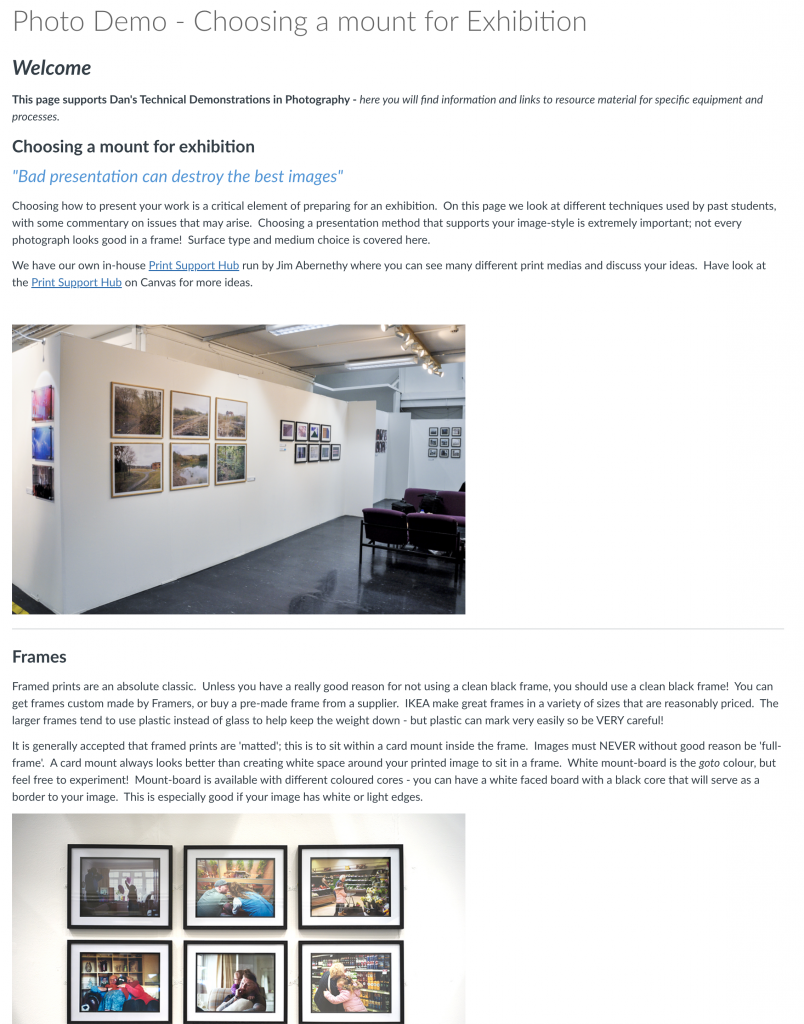
Theme of the Exhibition
Once we’d considered the exhibition videos, had a discussion about how we thought we proceeded, Sylvia gave us a task in groups of three, there were only six of us there. We had to come up with what we thought might be a theme for the exhibition based upon the information we’d seen from everyone else’s Practice Reviews.
Shelliw, Noah and I thought about each other’s presentations this morning and discussions around or works then made a small mind map of key words from the sessions. We looked at each of them but I had an overarching thought before we’d got this far, as Sylvia had mentioned there might be a word that linked all of our work together last week. She didn’t tell us what she thought the word might be, but I’d been contemplating what it could be. It seemed like “Time” was a good fit for most of the subjects that we were looking at on the page.`the other group of three came up with the word “Journey” as their possible link, and we discussed our output.
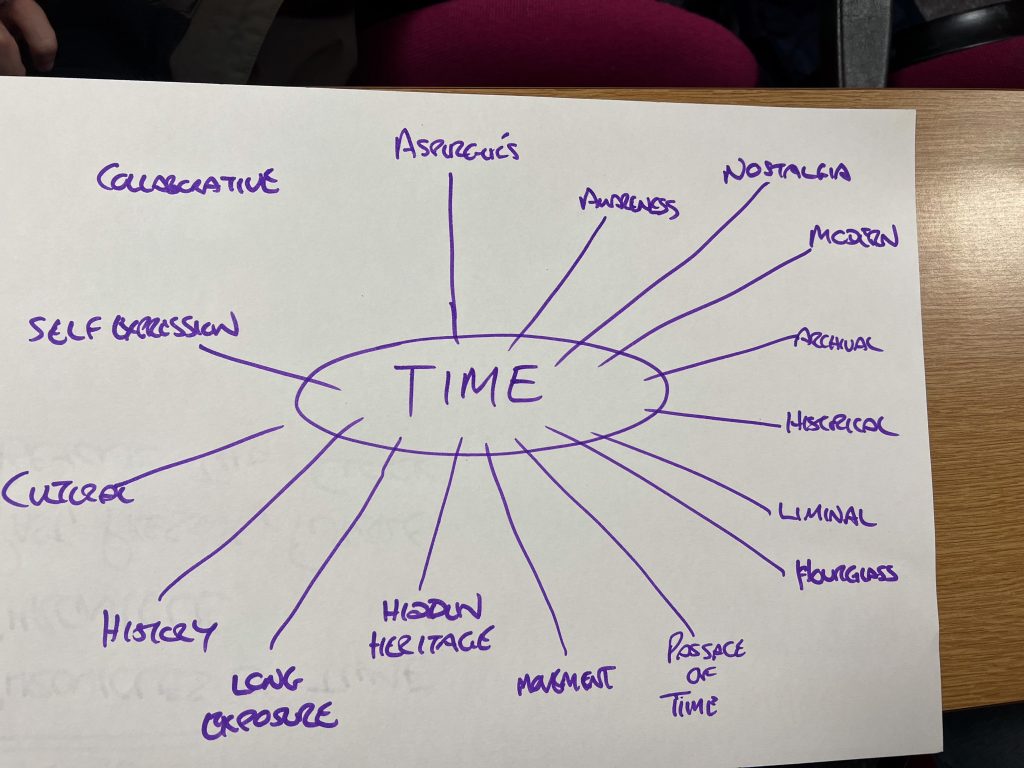
Once we’d come up with a linking theme we were tasked with a couple of minutes to come up with an idea for the title of the exhibition that linked all of the artists and work in the exhibition together.

Our basic list came about from a short brainstorm and there were a couple in the list that I’d use. Favourites would be Chronicle and Passage for me and I think that they might fit in with the Journey link that the other three classmates came up with.
Summary
Today was a mix of discussing our ideas for our practice and how we might consider presenting it to the wider world. An exhibition is something that requires careful planning and prep in order for it to be successful.
Once I get somewhere with some of my work and I’m happy that it looks like it might fit I’ll be able to consider how it might fit in with the rest of my coursemates work. There will be a great deal of work to do, collaborating together to come up with a concrete plan and then execute it flawlessly.
Be First to Comment